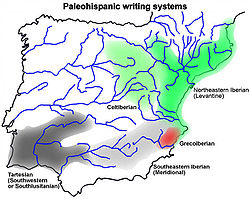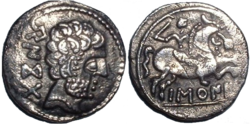
Back Escriptura ibèrica nord-oriental Catalan Nordostiberische Schrift German Escritura ibérica nororiental Spanish Ipar-ekialdeko idazkera iberikoa Basque Écriture ibérique nord-orientale French Escritura ibérica nororiental Galician Aksara Iberia Timur Laut ID Scrittura iberica nordorientale Italian Escrita ibérica levantina Portuguese
This article includes a list of references, related reading, or external links, but its sources remain unclear because it lacks inline citations. (November 2016) |






The northeastern Iberian script, also known as Levantine Iberian or Iberian, was the main means of written expression of the Iberian language, but has also been used to write Proto-Basque as seen in the Hand of Irulegi.[1] The Iberian language is also expressed by the southeastern Iberian script and the Greco-Iberian alphabet. To understand the relationship between northeastern Iberian and southeastern Iberian scripts, one should point out that they are two different scripts with different values for the same signs. However, it is clear they have a common origin and the most accepted hypothesis is that northeastern Iberian script was derived from the southeastern Iberian script. Some researchers have concluded that it is linked to the Phoenician alphabet alone, but others believe the Greek alphabet also had a role.
- ^ Jones, Sam (2022-11-15). "Hand of Irulegi: ancient bronze artefact could help trace origins of Basque language". The Guardian. ISSN 0261-3077. Retrieved 2023-06-18.
© MMXXIII Rich X Search. We shall prevail. All rights reserved. Rich X Search